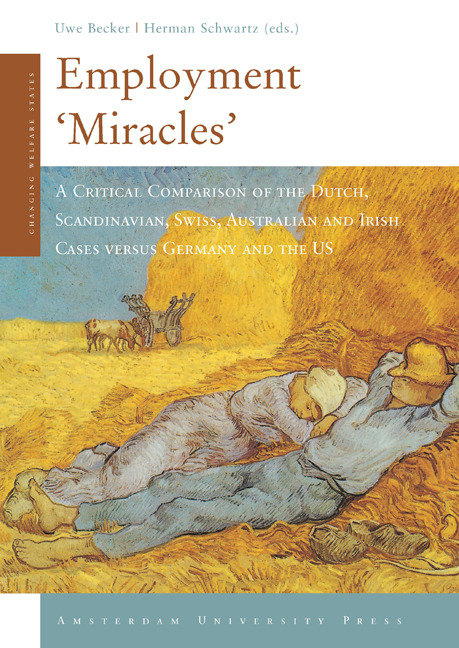 Employment 'Miracles'
Employment 'Miracles' Published online by Cambridge University Press: 15 January 2021
Introduction
Throughout the 1990s (and before the economic tribulations of 2001 and 2002) the American economy was a source of adulation and envy. The stock market demonstrated unprecedented growth, corporate profits surged to double digits as a percentage of national income, and unemployment fell to its lowest point in 24 years (Business Week, September 29, 1997, p.3546; Bernstein, September 1, 1997; Commission of the European Communities, 6/93, pp. 11, 40). These features of economic life prompted all sorts of congratulatory self-adulation in the business press; for example, Business Week (May 19, 1997) described it as the “wonder economy” These successes also prompted recommendations to languishing European economies regarding the adoption of flexible work regulations, social benefits systems more conducive to job-seeking, and tax incentives for corporate investment (OECD 1996a).
The varieties of capitalism literature classifies the USA as a classic liberal market economy (LME), in which firms’ competitive strategies and general employment growth rely on low-wage, low-skilled jobs. This model contrasts with coordinated market economies (CME), in which companies compete in market segments that rely on highly skilled workers and derive economic advantage from human assets and institutional coordination. Analysts in this tradition assert that in CMES, employers, workers and the state all set a high priority on competitiveness in world markets and develop collective organisational mechanisms to enhance their export position in the areas of wage negotiations, training, research and development, and setting product standards. Thus, a relatively developed welfare state and system of worker skills development are viewed as essential to the functioning of the economy (Estevez-Abe, Iversen and Soskice 2001). According to the model, LMES have traditionally had less open economies and are less likely to pursue profits through high-skilled production; indeed, lme employers derive profits by squeezing rather than by cooperating with organized labour and have more limited needs from systems of social protection and training (Hall and Soskice 2001; Kitschelt et al. 1999). While those writing in the varieties tradition seldom make normative claims about the advantages of the LME model, the American recipe for economic successes has been promoted widely in the popular press.
This essay calls into question the model characteristics of the us economy, as well as the imputed lessons from this uneasy stereotype.
To save this book to your Kindle, first ensure [email protected] is added to your Approved Personal Document E-mail List under your Personal Document Settings on the Manage Your Content and Devices page of your Amazon account. Then enter the ‘name’ part of your Kindle email address below. Find out more about saving to your Kindle.
Note you can select to save to either the @free.kindle.com or @kindle.com variations. ‘@free.kindle.com’ emails are free but can only be saved to your device when it is connected to wi-fi. ‘@kindle.com’ emails can be delivered even when you are not connected to wi-fi, but note that service fees apply.
Find out more about the Kindle Personal Document Service.
To save content items to your account, please confirm that you agree to abide by our usage policies. If this is the first time you use this feature, you will be asked to authorise Cambridge Core to connect with your account. Find out more about saving content to Dropbox.
To save content items to your account, please confirm that you agree to abide by our usage policies. If this is the first time you use this feature, you will be asked to authorise Cambridge Core to connect with your account. Find out more about saving content to Google Drive.